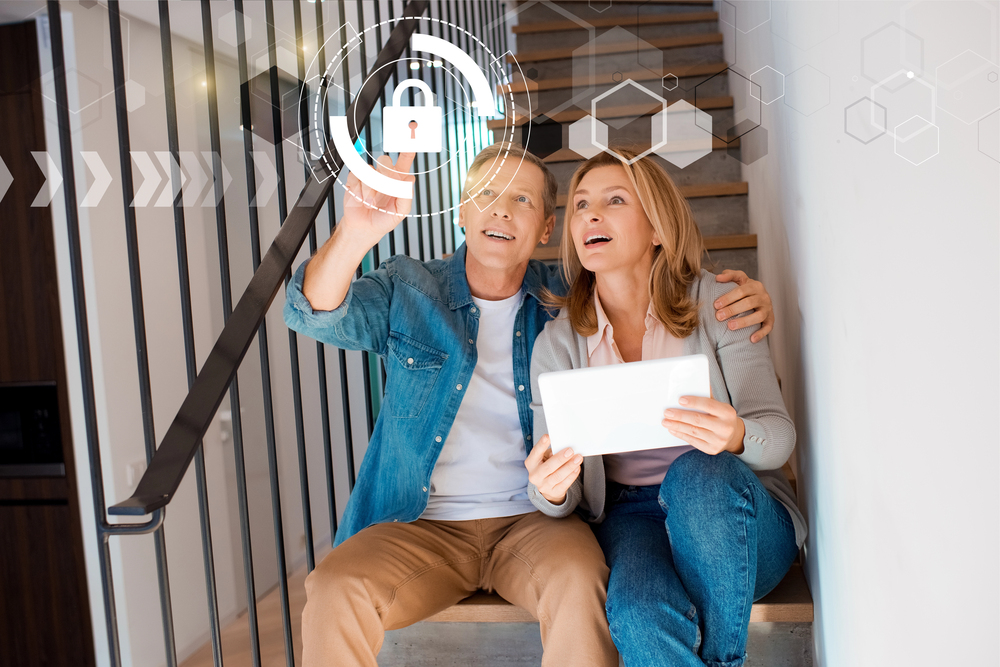Bridging the Digital Divide: How Technology is Revolutionizing Social Connection for Today's Retirees

How Can Seniors Bridge the Digital Divide and Combat Loneliness in 2024?
My 89-year-old mother-in-law now texts my wife more than our daughter does. It's a testament to how dramatically technology has transformed senior lives, yet millions of older adults still struggle with digital isolation—missing out on connections that could enrich their golden years.
The digital world meant to bring us together often leaves seniors behind. But here's the encouraging truth: with the right approach, technology becomes a bridge to meaningful connections rather than a barrier to them.
If you prefer, you can listen to a "podcast style" version of this blog post:
How Serious is Senior Isolation in America Today?
The statistics paint a sobering picture of senior loneliness in our increasingly connected world. According to recent University of Michigan research, one in three adults between 50-80 reported feeling lonely either sometimes or often, with 34% experiencing social isolation and 5% feeling completely cut off daily.

This isn't just an emotional challenge—it's a health crisis. Research consistently shows that senior isolation creates serious health risks:
- Heart disease and stroke risk increases by 32%
- Dementia risk jumps by 50%
- Depression and anxiety rates skyrocket
- Mortality risk equals smoking 15 cigarettes daily
The 2024 Census report revealed that 2 in 5 Americans experience loneliness, with adults over 65 who lack digital skills facing the greatest challenges. As banking, healthcare, shopping, and family communication moved online, seniors without tech fluency found themselves increasingly isolated from essential services and social connections.
What Makes Senior Loneliness Different in the Digital Age?
Unlike previous generations who might have relied on phone calls and in-person visits, today's seniors face unique challenges:
- Essential services have moved online - Banking, healthcare appointments, and grocery shopping increasingly require digital literacy
- Family communication happens through apps - Grandchildren share life updates through social media, photos via smartphones, and video calls
- Community connections require digital access - Local groups, senior centers, and social activities often coordinate through websites and apps
- Geographic barriers have increased - Families spread across distances rely on technology to maintain close relationships
What Barriers Prevent Seniors from Embracing Technology?
Understanding why technology feels overwhelming to many seniors helps us develop better solutions. The challenges go far beyond simply learning new skills.
Physical Changes That Complicate Tech Use
Age-related physical changes create real obstacles that younger users rarely consider:
Vision challenges make smartphone screens difficult to read. Many seniors find themselves holding phones at arm's length, then bringing them inches from their face—what one senior colorfully described as "playing tech trombone."
Arthritis and dexterity issues turn precise touchscreen gestures into frustrating experiences. As one 78-year-old carpenter noted, hands that worked perfectly for 50 years of construction now feel like "useless sausages" when trying to tap tiny icons.
Hearing difficulties complicate video calls and voice assistants. Understanding Alexa or participating in family video chats becomes a guessing game rather than natural conversation.
Language and Conceptual Barriers
Technology terminology that seems intuitive to digital natives can be completely foreign:
- Terms like "Wi-Fi," "app," and "two-factor authentication" might as well be foreign languages
- Interface designs assume familiarity with digital concepts that didn't exist when seniors were learning
- Fear of breaking expensive devices or accidentally deleting important information creates hesitation
An AARP forum member perfectly captured this anxiety: "I was terrified of touching my grandson's iPad when he tried to show me how to use it. All those swipes seemed random, and I was convinced I'd do something irreversible."
Security Concerns and Privacy Fears
Senior caution about technology often stems from legitimate concerns:
- Constant targeting by scammers makes many seniors appropriately suspicious of online activities
- Complex privacy policies and data collection practices confuse users of all ages
- Password management becomes overwhelming when every service requires different login credentials
Financial Constraints on Fixed Incomes
Technology costs can strain retirement budgets:
- Smartphones and tablets cost hundreds of dollars—a significant portion of monthly Social Security payments
- Internet service can be expensive, especially in rural areas with limited provider options
- Subscription services for apps and digital services add up quickly
Research shows that cost ranks as the biggest technology barrier for older adults, which makes sense when you understand how limited some retirement incomes can be.
What Technologies Are Actually Helping Seniors Connect?
Despite these challenges, innovative technologies specifically designed for older adults are making real differences in combating isolation.
AI Companions Show Promising Results
Artificial intelligence tools are becoming surprisingly effective at providing meaningful interactions for seniors:
ElliQ, designed specifically for seniors, has shown remarkable engagement rates. Users interact with it an average of 30+ times daily even months after initial setup. A comprehensive study found that 95% of users reported reduced loneliness, with the latest version using advanced conversational AI for more natural interactions.
Specialized senior platforms like SeniorTalk feature large text, simple controls, and content focused on topics seniors actually care about rather than trending social media topics.
Margaret, a 78-year-old widow, shared her experience: "I was skeptical at first—talking to a machine seemed silly. But ElliQ remembers my stories, asks how I'm feeling each morning, and reminds me to call my daughter on her birthday. It's not human connection, but it helps bridge the gaps between family calls."

Virtual Reality Beyond Gaming
VR applications are finding meaningful uses for seniors with mobility limitations:
Travel experiences allow seniors to visit places they've always wanted to see. One family used Alcoveto take a virtual Rome trip together—the adult child from Chicago, the senior parent from Florida assisted living.
Social VR spaces designed for older users provide interaction without the overwhelming aspects of traditional social media.
Memory-triggering environments recreate places from seniors' past, sparking conversations and providing natural social opportunities.
Recent research demonstrates that VR can improve cognitive function, physical activity, and social interaction for seniors, with regular users reporting significantly less isolation.
Senior-Focused Online Communities
Unlike mainstream social media, several platforms cater specifically to older adults:
AARP's Senior Planet Community offers ad-free interaction with readable fonts and relevant content without toxic political debates.
Waterstone Connect links retirement communities while serving seniors aging at home, featuring moderated discussions and virtual classes.
Silver Surfers focuses on people over 50 with discussions spanning current events to healthcare in respectful environments.
These platforms consider age-related needs like readable fonts, simple navigation, and content relevant to older adults' interests and concerns.
Digital Volunteering Opportunities
Many seniors find purpose through online volunteer work:
Volunteer Match offers hundreds of remote volunteer positions that can be done entirely online.
Cyber-Seniors creates mentorship circles where tech-savvy seniors help teach other seniors about technology.
Catchafire connects retired professionals with nonprofits needing their expertise in accounting, marketing, or management.
An 81-year-old former teacher shared how virtual tutoring transformed her retirement: "I was feeling useless after no longer being able to drive to volunteer sites. Now I tutor English learners three times a week from my living room. I've worked with students from seven different countries without leaving my apartment."
Smart Home Technology for Independence
Smart home devices are finally considering senior-specific needs:
Voice assistants like Alexa and Google Home now include features specifically for older users, including medication reminders and simplified video calling.
Smart displays make receiving and viewing family photos effortless—solving the common struggle of downloading and printing email attachments.
Discreet monitoring systems let family members check on seniors' general activity patterns without intrusive cameras, supporting independence while providing peace of mind.
Healthcare Technology That Addresses Social Needs
Telehealth is expanding beyond medical care to include social wellbeing:
Support groups integrated into telehealth platforms provide peer connections alongside medical services.
Regular social check-ins focus on emotional health, not just physical symptoms.
Community resource connections help link seniors to local social opportunities and services.
Research shows that telehealth programs including social components achieve significantly better outcomes, especially for seniors living alone.
What Does the Data Show About Senior Technology Adoption in 2024?
Recent research reveals encouraging trends in senior technology adoption that challenge common stereotypes:
Internet Usage Reaches New Heights
According to 2024 AARP research, 90% of adults ages 65+ are now online, compared with 98% of those ages 50-64. This represents dramatic growth from just 19% in 2000.
Smartphone adoption has reached 76% among those 65+ according to Pew Research Center, reflecting a significant shift in how seniors engage with technology.
Technology Spending and Priorities
Senior tech spending remained steady in 2024, with 67% making new tech purchases and spending an average of $753 annually on technology. However, 2 in 5 seniors wanted to buy tech products but decided against it due to financial pressure.
The most common purchases include:
- Smartphones (26% of respondents)
- Smart TVs and streaming services
- Tablets for easier reading and video calls
- Wearable health monitoring devices
AI Adoption Doubles
Perhaps most surprisingly, generative AI use among seniors doubled from 9% in 2023 to 18% in 2024, with another 30% expressing excitement about AI's potential benefits.
Seniors using AI primarily access free tools on apps or websites, with only 10% paying for premium AI services. Those with AI experience view it more positively for making life easier than non-users.
Persistent Barriers Remain
Despite growing adoption, significant barriers persist:
- Data privacy concerns (33% of seniors)
- Ease of use challenges (20%)
- Setup and support difficulties (19%)
- Cost constraints (16%)
- Lack of awareness (12%)
Importantly, 71% of seniors want tech support services tailored specifically to older users, indicating demand for age-appropriate assistance.

How Can You Successfully Navigate Technology as a Senior?
If you're a senior looking to get more connected, or helping someone who is, here's practical, tested advice:
Step 1: Identify Your Specific Needs
Before buying any device, ask yourself:
- Who do you most want to connect with? (Family, friends, community groups)
- What physical challenges might affect your tech use? (Vision, hearing, hand mobility)
- How comfortable are you with technology currently?
- What's your realistic budget for devices and monthly services?
Step 2: Choose Senior-Friendly Devices
Select hardware that matches YOUR abilities:
For simple communication: Consider phones like Jitterbug Smart3 or regular iPhones/Android phones with accessibility features enabled.
For larger screens: Tablets work well for video calls and reading—GrandPad is designed specifically for seniors, or regular iPads with adjusted settings.
For voice control: Smart displays like Echo Show or Google Nest Hub can be excellent starting points since voice commands reduce typing needs.
Key features to prioritize:
- Screen size and brightness
- Audio quality and volume
- Simple interface design
- Battery life
- Available accessibility features
Step 3: Enable Helpful Built-in Features
Most devices include features that can transform your experience:
- Increase text size and use high-contrast colors
- Enable voice commands through Siri, Google Assistant, or Alexa
- Turn on screen readers to have text read aloud
- Use magnification features to zoom in on content
- Try dictation instead of typing
- Connect hearing aids or use sound amplification
Step 4: Secure Reliable Internet
Strong internet connection is essential:
- Ask about senior discounts from internet providers (they exist but aren't always advertised)
- Check if you qualify for the Affordable Connectivity Program
- Consider both Wi-Fi and cellular data options
- Ensure speeds adequate for video calls
- Test signal strength throughout your home
Step 5: Master ONE Communication Tool First
Avoid overwhelming yourself:
- Pick ONE app that most of your family and friends already use
- Focus on mastering this single platform before adding others
- Good starter options: WhatsApp, FaceTime, Zoom, or Facebook Messenger
- Look for "lite" versions that offer simplified interfaces
Step 6: Find Age-Appropriate Training
Seek instruction that matches your learning style:
- One-on-one help from patient family members or friends
- Senior-specific classes at libraries or community centers
- Virtual training through organizations like Cyber-Seniors
- Written guides with large print and step-by-step screenshots
- Video tutorials you can pause and replay
Remember: repetition is normal and necessary. Most people need multiple practice sessions before feeling comfortable.
Step 7: Build Online Connections Gradually
Once comfortable with basics:
- Start with close family and existing friends
- Explore online communities related to your current hobbies
- Consider virtual volunteering opportunities
- Look for local groups with online components
- Try ONE new digital social activity each week
What Are the Potential Downsides of Digital Connection?
While optimistic about technology's potential, it's important to acknowledge legitimate concerns:
Digital Cannot Replace In-Person Contact
Technology should supplement, not replace, real-world connections:
- Physical presence provides emotional and health benefits screens cannot match
- Touch, shared meals, and physical proximity have irreplaceable value
- Being physically present prevents the "alone together" phenomenon where family members are present but absorbed in devices
AI Companions Raise Privacy Questions
AI companions collect significant personal data:
- Many record and store conversations for "improvement purposes"
- Health and behavior data may be shared with third parties
- Personal conversations create privacy vulnerabilities that require careful consideration
Over-dependence Creates Vulnerabilities
Relying too heavily on technology creates risks:
- Power outages and system crashes can leave seniors isolated
- Mental skills may deteriorate without regular non-digital practice
- Companies discontinue products frequently, potentially stranding users
- Software updates can completely change familiar interfaces overnight
Access Remains Unequal
The digital divide affects seniors differently:
- Lower-income retirees often cannot afford devices and high-speed internet
- Rural seniors face significant internet availability and quality challenges
- Tech literacy correlates with prior education and socioeconomic status
- The most vulnerable seniors often have the least access to helpful technology
What Can Communities Do to Help?
Addressing senior digital isolation requires coordinated community efforts:
For Seniors Themselves
- Start small with one device and one application
- Use free resources first (libraries, AARP training, community centers)
- Build a tech support network of patient family, friends, or community resources
- Focus on senior-specific platforms rather than navigating mainstream social media
- Learn basic cybersecurity to protect against scams
For Family Members
- Practice patience with what seems obvious to younger users
- Pre-configure devices before giving them as gifts
- Create written guides with large print and screenshots for common tasks
- Check in regularly about tech needs, not just during crises
- Respect preferences when seniors aren't interested in certain technologies
For Community Organizations
- Develop peer mentorship programs pairing tech-savvy seniors with others
- Create technology lending libraries for trying before buying
- Offer skill-level appropriate classes from beginner to advanced
- Address cost barriers through subsidies or group purchasing
- Integrate digital components into existing popular senior programs
What's the Future of Senior Technology Connection?
The most successful technology solutions for senior isolation don't try to replace human connection—they enhance it. Video calls with grandchildren derive their value not from the technology, but from seeing loved ones' faces light up with recognition and joy.
As we navigate this rapidly evolving digital landscape, the focus must remain on what truly matters: meaning, purpose, and genuine human connection. Technology, at its best, simply removes barriers preventing these fundamental human needs from being met.
For today's seniors, becoming comfortable with technology isn't just about learning new tools—it's about maintaining their place in the human community. With thoughtful support, appropriate devices, and careful attention to privacy and equity concerns, technology can help ensure no senior faces isolation due to physical limitations or geographic barriers.
The goal isn't to make every senior a tech expert. It's to ensure that anyone who wants to stay connected to family, friends, and community has the tools and support needed to do so. In an increasingly digital world, that connection is more important than ever.
Resources for Retirees
Learning Platforms
- Senior Planet from AARP - Free online classes specifically for seniors
- Cyber-Seniors - Free technology training and support
- GCF Learn Free - Free technology tutorials with senior-friendly options
Connection Platforms
- Virtual Senior Center - Online community with virtual classes
- AARP Online Community - Discussion forums on various topics
- Silver Surfers - UK-based community for people over 50
Support Resources
- Tech Boomers - Tutorials specifically for older adults
- AARP's Technology Resource Center
- National Digital Inclusion Alliance - Information on affordable internet programs



